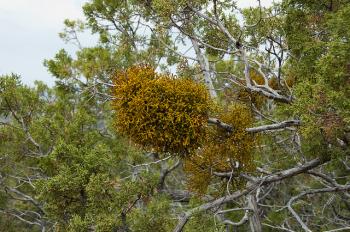December 15, 2018
Question:
What trees are resistant to mistletoe?
- John Allen, NMSU Extension Agriculture Agent & Program Director, Socorro County
Answer:
OK, firstly, no one really calls mistletoe “the kiss of death” as I did in this week’s column title. That’s my attempt to grab readers by the eyeballs. Mistletoes don’t tend to kill their tree hosts, but it is possible, and they certainly can do harm, leaving the host plants more vulnerable to other stressors. The genus name for true mistletoe is Phoradendron, which means “tree thief.”

Mistletoe is usually green or at least a puke-green color. Winter is a good time to detect it in deciduous trees because the tree leaves have dropped, and the mistletoe is temporarily exposed. Greenness is a clue that mistletoe contains chlorophyll and can photosynthesize on its own, so it’s not necessarily stealing sugars from the host plant. It’s still a parasite because it lacks normal root tissues. Instead of roots, mistletoe develops root-like structures called haustoria that work themselves down past the bark and into the branches where they tap into vascular tissues to steal water and nutrients.
I have had reports from concerned bosque-lovers up and down the Rio Grande that they are seeing more and more mistletoe on our cottonwoods. That would be the true mistletoe (AKA leafy mistletoe). In addition to cottonwoods, true mistletoe commonly infects oaks, willows, locusts, ashes, and others, so careful attention is needed to avoid long-term damage.
Even though it is the same genus as other true mistletoes, juniper mistletoe (Phoradendron juniperinum) only infects juniper tree species. It’s the dwarf mistletoes (Arceuthobium spp.) that are known for infesting many other conifers. These evergreen mistletoes are sneaky because they’re hidden year-round. If you pay close attention, though, you can find them because they tend to be a yellow- green color (hence my describing them as “pukey”) compared to the healthy foliage.
The key to selecting resistant species is knowing what type of mistletoe is affecting the trees in your area. For true mistletoe, Chinese pistache, crape myrtle, and the golden rain tree are a few tree species that are recommended in parts of New Mexico and are known to be relatively resistant. If you only have dwarf mistletoe or that particular species of juniper mistletoe, you can still plant oaks and cottonwoods without immediate worry. Piñon and rocky mountain juniper are examples of pine trees that are recommended in areas where dwarf mistletoe is impacting ponderosas.

In a 2016 publication, Dr. Kim Coder, Tree Biology & Health Care Professor at the University of Georgia, summarized some of the effects and management of American mistletoe (Phoradendron serotinum):
- Mistletoe is effective as a parasite because of its battery of growth regulation signals which fool a tree into providing resources while minimizing compartmentalization. It chemically “wires” itself into tree resource allocation systems and skirts tree defenses.
- Trees are stressed, decline, and pushed to structural failure and biological dysfunction by mistletoe.
- Continual vigilance and crown cleaning (especially of female clumps before berries appear) is recommended to prevent build-up of mistletoe populations. Under intensive landscape management, a program of careful pruning and repeated chemical treatment is recommended.
- Elimination of mistletoe, especially in socially significant and old trees, is crucial.
Dr. Coder will be speaking about trees in drought at the upcoming ThinkTreesNM urban tree care conference in Albuquerque, January 17-18, 2019.
Unfortunately, we are expecting higher susceptibility to all sorts of pests, including mistletoe and dwarf mistletoe, in our forest and landscape trees as temperature and water stress increase with climate change. So take a look in your tree canopies for mistletoe clusters and figure out the best way to remove them pronto. For links to more information on detection and control, including the NMSU Extension Publication, "True Mistletoe," visit Desert Blooms.
Marisa Y. Thompson, PhD, is the Extension Horticulture Specialist, in the Department of Extension Plant Sciences at the New Mexico State University Los Lunas Agricultural Science Center, email: desertblooms@nmsu.edu, office: 505-865-7340, ext. 113.
Links:
For more gardening information, visit the NMSU Extension Horticulture page at Desert Blooms and the NMSU Horticulture Publications page.
Send gardening questions to Southwest Yard and Garden - Attn: Dr. Marisa Thompson at desertblooms@nmsu.edu, or at the Desert Blooms Facebook page.
Please copy your County Extension Agent and indicate your county of residence when you submit your question!